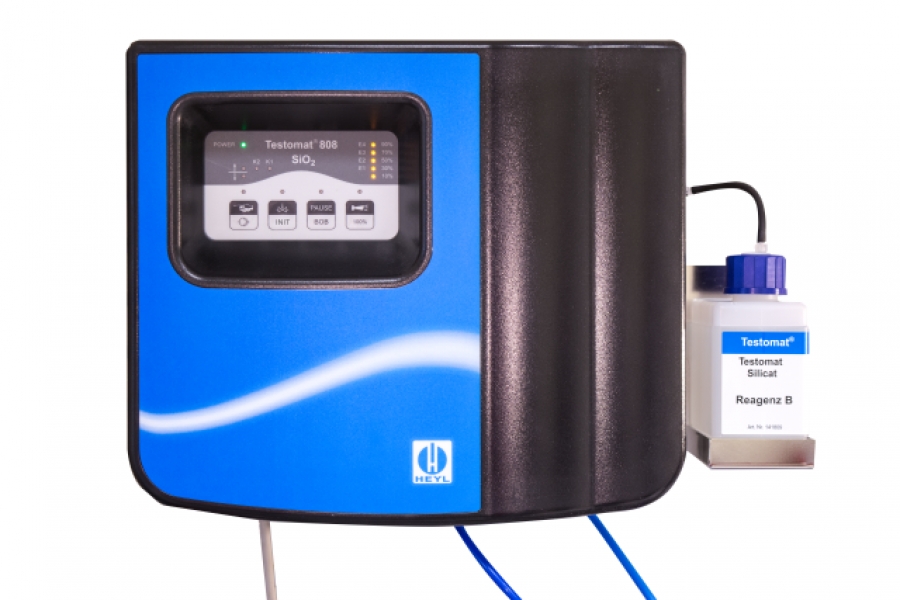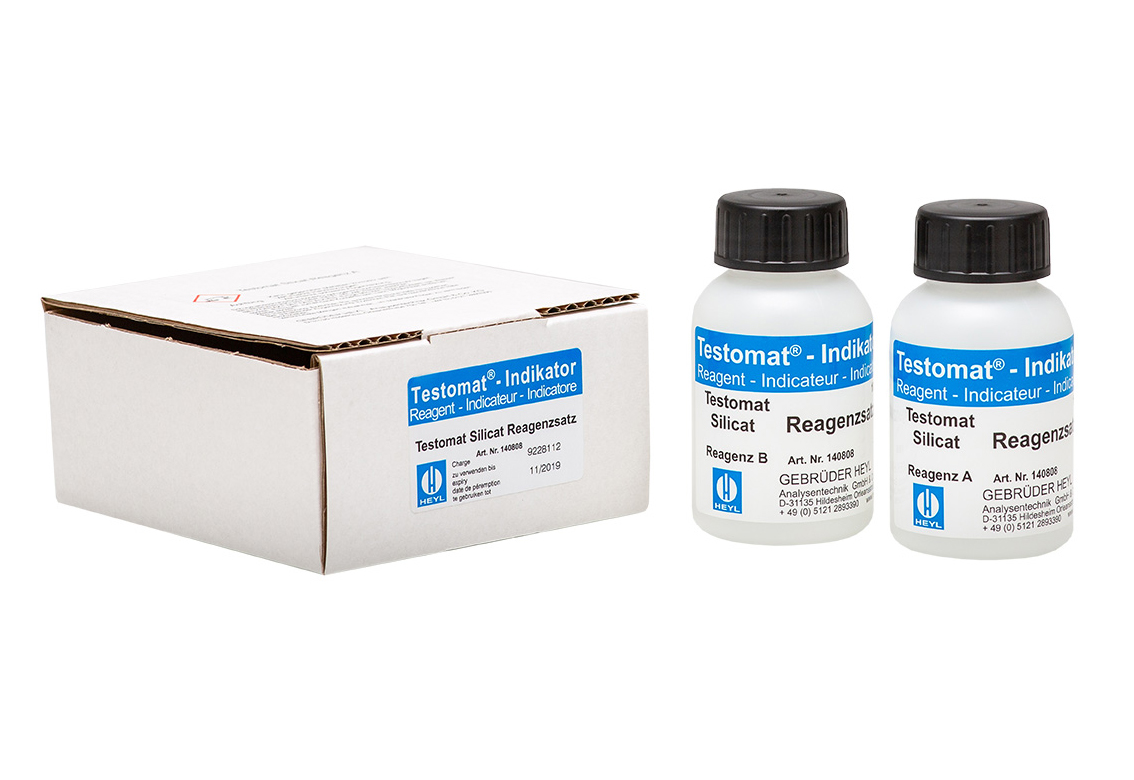Silicates in water (SIO2)
Silicate is an umbrella term for a variety of silicon compounds. Silicates are defined as salts of ortho-silicic acid. In nature, silicon plays a not insignificant role. Silicon (Si) is a semimetal, which at the same time represents the second most common element in the earth’s crust after oxygen with about 28 percent by weight.
The oxygen acids of silicon (SiO2 – in water) are called silicic acids.
Orthosilicic acid is a very weak acid. It is formed by decomposition of silicon tetrahalides with water. Further water splitting leads to orthosilicic acid and metasilicic acid. If the last water is also removed, the silicaanhydride SiO2 is formed.
Due to its high chemical stability, silicon dioxide is used in a wide variety of applications. The best-known application is the production of glass, in which silica is the main component. Other applications include use as a filler for plastics, sealants and car tires, or as a release agent in spices or spice mixtures. As a food additive, silicic acid anhydride bears the designation E 551.
In nature, supporting skeletons of silicic anhydride occur in plant and animal organisms, such as the diatoms, radiolarians, glass sponges (Hexactinellida) and horsetails, which are widespread in the sea. The silica anhydride skeletons of dead diatoms and radiolarians sink to the seafloor, where they accumulate and form deposits of diatomaceous earth (diatomaceous earth) and radiolarian mud, respectively. Miocene deposits contain 70-90% SiO2, 3-12% water, and trace metal oxides.
Silicic acid also occurs in groundwater . Rainwater or seepage water, which runs down through the soil layers and contains carbonic acid, absorbs silicic acid from the silicates in the soil minerals. Therefore, drinking water also contains small amounts of silica.
Together with phosphates (such as polyphosphates), silicate is also used in drinking water treatment to protect piped water from corrosion and limescale buildup. It is therefore not uncommon to find elevated silicate levels in pipe water when measured by droplet test or as part of laboratory analysis.
In this context, it should be noted that water suppliers often do not provide values for the SiO2 content in the accessible documentation on drinking water quality in the catchment area. Knowledge of this is all the more important when planning and designing water treatment plants and monitoring them. If silicate is desired in the water to protect the pipelines, this can at the same time lead to problems if the water is insufficiently treated for production processes.
One such process is, for example, steam generation for turbines in the power plant sector. Among the numerous impurities in the steam-water cycle, silica plays a special role because it has a high solubility in water vapor.
In turbines areas arise where salts and SiO2 can be deposited depending on pressure. This mixture can deposit on the turbine blades and guide vanes and form a firmly adhering layer. This layer disturbs the flow-optimized geometry of the turbine blades and leads to lower efficiency.
The water treatment plants of steam power plants are used to treat the waters of the various systems in such a way that corrosion and deposits are limited and wastewater is treated. The main water treatment plants of steam power plants are:
- Water-steam cycle conditioning
- Auxiliary water treatment plant with deionizer generation
- Condensate purification plant
- Cooling water treatment plant
- Inlet structure with rake and screening machine rail
- Waste water treatment plant
Regardless of the drinking water quality, the process water must be further treated to maintain efficient and reliable production. The exact requirements for the composition of process water vary greatly depending on the area of application, customer and industry.
Theprocess water is usually obtained from the municipal water supply, from wells or surface water, or from a combination of these water sources. Here, pretreatment is always required to match the water quality. Recycled water must be filtered and the make-up water must be freed from solids as required and softened in the next step.
It is also possible, instead of softening, which belongs to the ion exchange processes, to use membrane processes such as nanofiltration in the first treatment stages . In the further course of the process water treatment, a reduction of all dissolved substances in the water (especially salts) takes place. For this purpose, the reverse osmosis process has become established. Reverse osmosis systems are nowadays used in many areas where water with a low salt content and thus a low conductivity is of importance. It should be noted that the retention rate for dissolved substances in this process is 95 – 98%. Depending on the purity requirements of the water to be used, it may be necessary to use two-stage reverse osmosis or a combination of two stages and recirculation of the reverse osmosis concentrate. If very high demands are made on the purity of the water, other processes such as electro-deionization and mixed bed filters are used.
An important process in which silicates are undesirable in the process water is the cleaning, disinfection and downstream sterilization of medical products. Here, silicates (SiO2) must be eliminated from the water as far as possible, in particular to protect the instruments/medical devices to be treated and the equipment technology used here. The current recommended limit value is 0.4 mg/l SiO2 and is accompanied by a conductivity of the treated water of 1 µS. Learn more about this in our section Sterile processing – safety in the AEMP and Project in an eye clinic in the greater Hanover area.
Application solutions:
Steam generation is an essential element in the production and value chain in many industrial sectors. Typical areas of application are power plants, food production and the manufacture of pharmaceutical products, laundries, the timber industry and chemical plants.
Depending on the upstream boiler, two different types of deposits are considered. In natural circulating steam generators, mainly silica and boiler water constituents occur. In continuous steam generators, iron compounds such as FeO, Fe2O3, Fe3O4 predominate.
Another important process in which silicate plays an important role in this context is washdown. The aim of the blowdown process is to drain contaminated water from the steam boiler, which also removes a number of impurities such as precipitated sludge and dissolved solids. To appropriately control blowdown, continuous monitoring of control parameters such as silica content is required to assess the effectiveness of water chemistry in the steam boiler. It also avoids high fluctuations in boiler chemistry. The SiO2 concentration can sometimes rise up to several thousand ppb.
The most important measurement location for silica is the boiler feedwater system. Guidelines of the international professional association for power and heat generation VGB provide for one normal and two alarm levels for the concentration:
Normal operation < 20 ppb – The monitoring of chemistry in the steam-water cycle should be extended to include components of analytical measurement technology in order to identify optimization potential.
20 ppb < 50 ppb – Appropriate action should be taken to determine and correct the cause within one week. In addition, other measures are recommended to minimize possible damage to the equipment.
X > 50 ppb – Appropriate action should be taken to determine and correct the cause within one day. In addition, other measures are recommended to minimize potential damage to the equipment.
Whether through targeted introduction for pipeline protection or natural presence due to the water sources used, silicates are of great importance in the field of water treatment and the associated use for industrial purposes. Continuous monitoring (silicate monitoring or silicate measurement) serves to protect the treatment components used, the technical components used and to monitor the suitability of the treated water for further use in the industrial environment.

